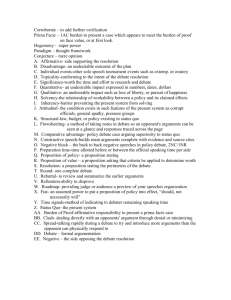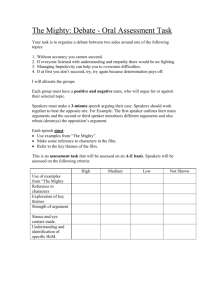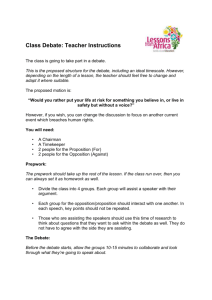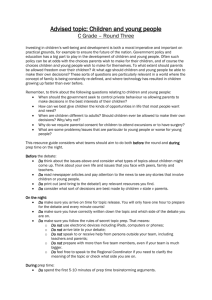An introduction to British Parliamentary Debating
advertisement
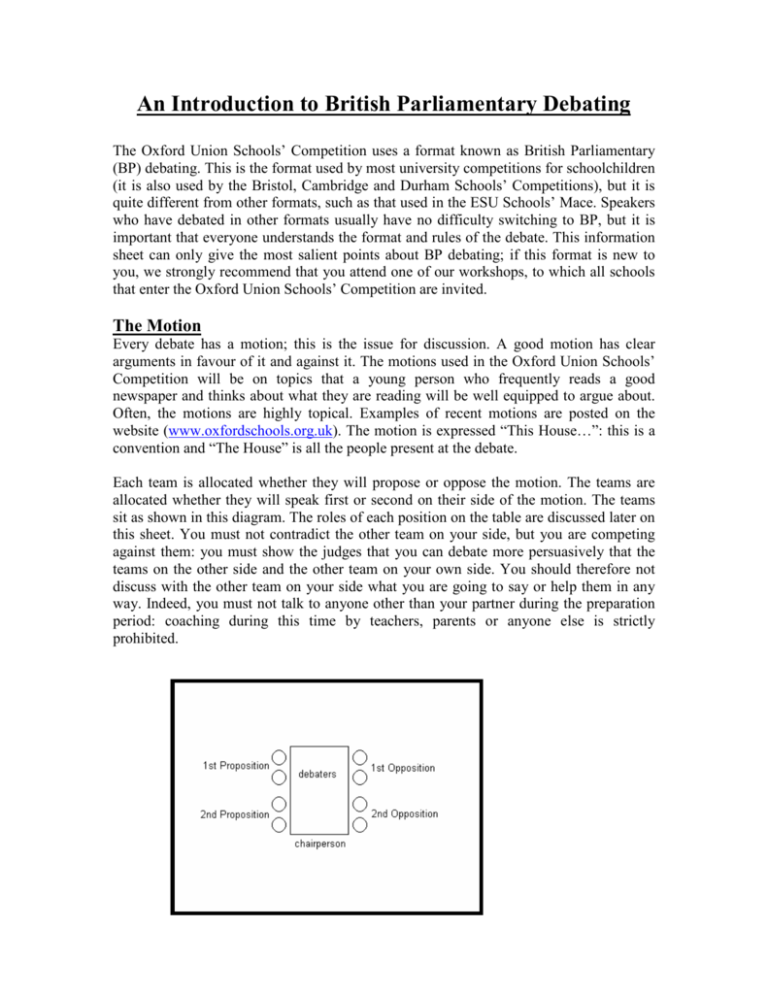
An Introduction to British Parliamentary Debating The Oxford Union Schools’ Competition uses a format known as British Parliamentary (BP) debating. This is the format used by most university competitions for schoolchildren (it is also used by the Bristol, Cambridge and Durham Schools’ Competitions), but it is quite different from other formats, such as that used in the ESU Schools’ Mace. Speakers who have debated in other formats usually have no difficulty switching to BP, but it is important that everyone understands the format and rules of the debate. This information sheet can only give the most salient points about BP debating; if this format is new to you, we strongly recommend that you attend one of our workshops, to which all schools that enter the Oxford Union Schools’ Competition are invited. The Motion Every debate has a motion; this is the issue for discussion. A good motion has clear arguments in favour of it and against it. The motions used in the Oxford Union Schools’ Competition will be on topics that a young person who frequently reads a good newspaper and thinks about what they are reading will be well equipped to argue about. Often, the motions are highly topical. Examples of recent motions are posted on the website (www.oxfordschools.org.uk). The motion is expressed “This House…”: this is a convention and “The House” is all the people present at the debate. Each team is allocated whether they will propose or oppose the motion. The teams are allocated whether they will speak first or second on their side of the motion. The teams sit as shown in this diagram. The roles of each position on the table are discussed later on this sheet. You must not contradict the other team on your side, but you are competing against them: you must show the judges that you can debate more persuasively that the teams on the other side and the other team on your own side. You should therefore not discuss with the other team on your side what you are going to say or help them in any way. Indeed, you must not talk to anyone other than your partner during the preparation period: coaching during this time by teachers, parents or anyone else is strictly prohibited. Basic rules and advice about structure • • • • • Speeches are five minutes in length. The first and last minutes are protected time – no points of information may be made during this time. Points of Information should be offered during the three minutes of unprotected time when members of the other side are speaking. Speeches should have a clear Internal Structure. It is often best to begin by attacking the arguments of previous speakers from the other side (especially the one just before you) and then to make you own points. Try to separate your arguments into two, three or four areas (e.g. a social argument, a political argument and an economic argument). Signpost your arguments clearly (e.g. “this is my first point”, “now to move onto my second points”, “lastly, looking at my third point” etc): this makes it much easier for the audience and the judges to follow your speech. Work as a team, ensuring that your arguments are consistent and complementary. The roles of the four teams Opening Proposition Team First speaker 1. Define the motion (see below). 2. Outline the case he and his partner will put forward and explain which speaker will deal with which arguments. 3. Develop his own arguments, which should be separated into two or three main points. 4. Finish by summarising his main points Second speaker 1. Re-cap the team line. 2. Rebut the response made by the first opposition speaker to his partner’s speech. 3. Rebut the first opposition speaker’s main arguments. 4. Develop his own arguments – separated into two or three main points. 5. Finish with a summary of the whole team case. Opening Opposition Team First speaker 1. Respond to the definition if it is unfair or makes no link to the motion. You can re-define (offer an alternative interpretation of the motion), but this can be risky and should only be done when the definition is not debatable (usually better to complain a little and hope the adjudicator gives you credit – “well this is a silly definition but we’re going to debate it and beat you on it anyway” approach). 2. Rebut the first proposition speech. 3. Outline the case which she and her partner will put forward and explain which speakers will deal with which arguments 4. Offer additional arguments (roughly 2) about why the policy is a bad idea, or develop a counter case (i.e. an alternative proposal). This decision is largely based on the circumstances of the debate, and only experience will provide guidance on this. Second speaker 1. Rebut the speech of the second proposition speaker. 2. Offer some more arguments to support your partner’s approach to the motion. 3. Summarise the case for your team, including your own and your partner’s arguments. Closing Proposition Team First speaker The first speaker must stake his team’s claim in the debate by doing one of the following: 1. Extend the debate into a new area (i.e. “this debate has so far focused on the developed world, and now our team will extend that to look at the important benefits for the developing world) 2. Introduce a couple of new arguments that make the case on his side more persuasive. Again, this decision depends on the scenario. This is quite a complex part of debating to master, but it is very important to add something new to the debate or you will be penalised. Second speaker The last speech of a debate is known as a Summary Speech. In it you should step back and look at the debate as a whole and explain why on all the areas you have argued your side has won. You can: 1. Go through the debate chronologically (this is not very advanced and usually not very persuasive either). 2. Go through one side’s case and then the other. 3. Go through the debate according to the main points of contention (this is the most persuasive and advanced way) explaining why on each of the main issues that have been debated have been won by your side. Closing Opposition Team First speaker This is very similar to the second prop role. 1. You must rebut the new analysis of the third proposition speaker. 2. You must also bring an extension to the debate – i.e. extend the debate into a new area or bring a couple of new arguments to the debate. Second speaker Like the closing proposition, the last opposition speaker must devote their whole speech to a summing up and should not introduce new material. Points of Information Points of Information are a very important part of BP. They enable you to keep involved throughout the whole debate, rather than just during your five minutes are up. They do not figure too heavily in most judging decisions, but in a close round where the teams are all similarly good at style and content could be the deciding factor. Teams that offer very few points of information are likely to be penalized heavily for failing to engage in the debate. ⇒ Points of information should be offered in unprotected time (i.e. in the time between the two time signals). ⇒ They should be offered by members of the opposite side only. ⇒ You offer a point of information by standing and saying “point of information”. ⇒ You should aim to offer one point of information every minute during someone else’s speech. This is just a rough guideline. If you offer too few it will look like you cannot argue against the point they are making, and if you offer too many it will look like you are trying to unsettle or harass the speaker. ⇒ Speakers may accept or decline the point of information in any way they like; the simplest is by saying “yes please”, or “no thank you”. ⇒ You should aim to accept two points of information during a five minute speech. ⇒ Points of Information should be quick and to the point (no more than about fifteen seconds). They should offer a new piece of information to explain why what the speaker is saying at the time is wrong. Dealing with Points of Information Many new debaters find points of information one of the scariest bits of debating. This is usually because they vastly overestimate the intelligence of the speakers on the other side. Remember confidence does not equal intelligence, it only gives that impression and is designed to do so. There are a number of ways of dealing with Points of Information. 1. Dismiss them briefly and then get on with your speech (if it was a stupid point). 2. Answer them more fully and merge your answer into what you were going to say next. 3. Say that you are planning to deal with that point later on in your speech and carry on where you were. If you do this, you absolutely MUST make it utterly explicit when you refute the point later on. You must not use this as a ducking tactic since adjudicators will notice. Case Building One of the most difficult skills in debating is preparing cases (i.e. being First Proposition). Many teams find it difficult to come up with a good case statement and supporting arguments in the 15 minutes that most tournaments allot for preparation time. The key to success is to recognise your time constraints and live within them. Every other team in the tournament will have similar restrictions placed on them when they are in opening proposition. Accept it and move on. Sometimes, the motion won’t be very helpful in locating a case. For example: • This House would use the force. • This House believes fish swim faster in cold water. These are known as Open Motions, and you will not encounter them in the Oxford Schools’ Competition. Usually the subject for debate more obvious. For example: • This House would legalise euthanasia. • This House would bomb North Korea. These are known as Closed Motions. Here, it is clear about what you should be arguing; you will be penalised for any attempts to debate about something else. You should identify your contention/case statement (even if it’s just a rewording of the resolution) in a one sentence. For Example: • “The proposition will argue that doctors in the UK should be allowed to administer lethal drugs to terminally ill patients.” • “We believe that the US and its allies should bomb North Korea now to halt its production of nuclear weapons.” Judges like succinct (one-sentence) case statements. A short case statement will help your own thought processes. It is not ok to run a case with no opposition to it at all. If your case is • tautological (true by definition: the Sun rises in the morning), • truistic (true by commonly accepted principles: Hitler was bad) you will be penalised, and will probably lose the debate by default. If the definition is tautological or truistic, the first opposition speaker should explain this, substitute a fair definition and then argue against this new definition. Having now identified the case statement, all you need to do is answer the following questions: 1. “How would we implement this resolution?” (model) 2. “Why should we implement this model?” (arguments) The Model The proposition’s model/plan should be introduced in the first minute of the first speaker’s speech. In building the model, you want to work out how your proposition will be implemented. Judges hate first proposition teams that take forever to get to the point. In the motion about euthanasia above, the first proposition team should outline how their plan would work, perhaps referring to somewhere where euthanasia is or has been legal (e.g. The Netherlands, Oregon, the Northern Territories of Australia). They should refer to things like the people who would be eligible (e.g. those of sound mind with terminal illnesses causing severe pain or distress, who have expressed a consistent wish to die), how these people would indicate that they wished to die and what safeguards there would be (e.g. two doctors agreeing independently about the patient’s condition). Often, motions do not demand an answer to the question “how”? The resulting debates are called “philosophical” debates and can be quite enjoyable. • This House believes that the Roman Catholic Church should ordain female priests. • You argue that the Roman Catholic Church SHOULD do this for all sorts of logical and theological reasons; you do NOT need to propose invading the Vatican to make them do it! • This House would not use economic sanctions as a tool of diplomacy. • This can be debated as a broad principle or first proposition could identify a specific country (e.g. Zimbabwe, Cuba, North Korea, Libya) and argue that sanctions should be lifted; the former case (broad principle) does not require a model, the latter (specific example) does. • This motion is semi-closed since the issue for debate is clear (it is about sanctions) but the proposition could reasonably define it in many ways (e.g. about different countries). The opposition could challenge the definition if the proposition started talking about something unrelated to sanctions; they could not challenge the definition if it was about a particular country they did not happen to know about. Having said that, proposition teams should not try to pick obscure examples in the hope that no-one has heard of them – it is better and fairer to concentrate on your arguments that on trying to outwit the opposition with the definition. • Semi-closed motions may be set in the Oxford Union Schools’ Competition.




